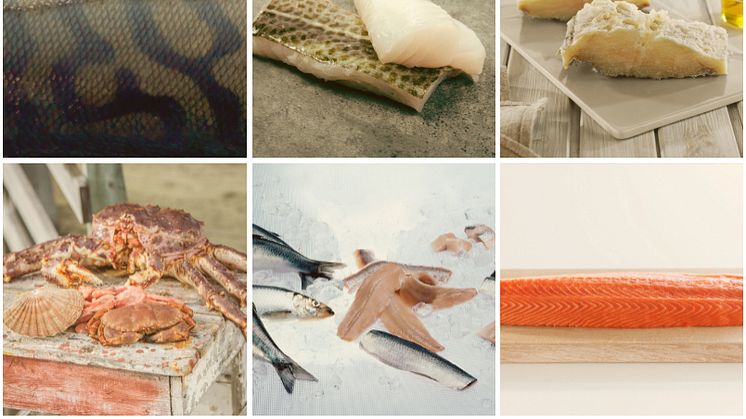
Press release -
Norwegian seafood exports equal earlier July records - despite a challenging situation in the markets
Three highlights from July export statistics
The value of seafood exports equalled last year's record for July. Contributing factors include:
- A weakened Norwegian krone has contributed to an increase overall, but there are relatively large differences between seafood species. Saithe and herring prices have held up relatively well compared with more expensive species such as salmon and cod where we see somewhat lower prices measured in euros and dollars
- We are experiencing weaker demand for salmon, especially in some Asian markets.
- It has been a good July for exports of frozen whitefish, compared with the same period last year. There are still challenges for some conventional markets.
“The currency situation is still favourable for export value, but the Norwegian krone has strengthened recently. At the same time, the situation in Asia has still not normalized after suspicions of infection in a food market in China in June. At the same time, general tourism is lower than last year, with fewer freight options and some restrictions in individual markets. The European markets are importing larger volumes overall, but at a lower price”, says director of market insight and market access at the Norwegian Seafood Council, Tom-Jørgen Gangsø.
Salmon exports worth NOK 5.6 billion – growth in volume
Norway exported 94,800 tonnes of salmon worth NOK 5.6 billion in July. This is a volume increase of 6 per cent but a reduction in value of 2 per cent or NOK 132 million from July last year.
So far this year, Norway has exported 595,000 tonnes of salmon for NOK 40.6 billion. The volume and value remain at the same level as last year. The average price for whole, fresh salmon in July was NOK 54.43 per kg against NOK 59.60 per kg in July last year.
“Weakened demand for Norwegian salmon, especially in Asia, as a result of covid-19, is the reason for the decline in value for salmon in July. Markets that have bought significantly smaller volumes are China, Hong Kong and Sweden. The supply of salmon to Poland, France and Germany, on the other hand, increased sharply”, says Paul T. Aandahl, Seafood Analyst with the Norwegian Seafood Council.
Large increase in volume of trout exports
Norway exported 7,200 tonnes of trout worth NOK 345 million in July. This is a volume increase of 43 per cent and a value increase of 15 per cent or 45 million compared to July last year.
So far this year, Norway has exported 38,700 tonnes of trout for NOK 2.2 billion. This is a volume growth of 31 per cent and an increase in value of 11 per cent or NOK 209 million from the same period last year.
Ukraine, USA and Finland were our largest trout markets in July.
Fresh and frozen cod see exports increase
Norway exported 1,900 tonnes of fresh cod, including fillets, to a value of NOK 84 million in July. This is an increase in volume of 31 per cent and an increase in value of 16 per cent or NOK 12 million from July last year.
So far this year, Norway has exported 37,900 tonnes of fresh cod, including fillets, for NOK 1.7 billion. This is a volume decrease of 8 per cent and a decrease in value of 3 per cent or NOK 51 million compared to the same period last year.
Denmark, Sweden and the Netherlands were the largest markets for fresh cod in July.
“It is low season for both catch and export of fresh cod at this time of year. The large percentage increase in the volume of fresh cod in July this year must be seen in connection with somewhat increased landings of fresh cod this year compared with July last year. The price is lower than last year, but on its way up again from the bottom in May, which is normal at this time of year”, says Ingrid Kristine Pettersen, Seafood Analyst with the Norwegian Seafood Council.
Norway exported 5,800 tonnes of frozen cod, including fillets, worth NOK 240 million in July. This is an increase in volume of 36 per cent and an increase in value of 37 per cent or NOK 65 million compared to July 2019.
So far this year, Norway has exported 46,200 tonnes of frozen cod, including fillets, for NOK 2.1 billion. This is an increase in volume of 5 per cent and an increase in value of 14 per cent or NOK 260 million from the same period last year.
China, the United Kingdom and the United States were the largest markets for frozen cod in July.
“There is volume growth for both frozen whole and fillets of cod. The largest volume growth for frozen fillets is in the United Kingdom and the United States in July, while exports of frozen whole cod increase to China, the United Kingdom and Portugal. The price of frozen fillet remains the same as last year, while the price of frozen whole cod continues to fall and is now below the 2018 level, says Ingrid Kristine Pettersen, Seafood Analyst with the Norwegian Seafood Council.
“At the same time, it is worth noting that blue halibut was the fourth most valuable whitefish species we exported in July. There has been a large growth compared to last year, which was an unusually weak month. Blue halibut is also one of the whitefish species with the greatest growth in July, and much of this was destined for the Chinese market”, says Ingrid Kristine Pettersen.
Significant decline in clipfish exports
Norway exported 4,500 tonnes of whole clipfish to a value of NOK 225 million in July. This is a volume reduction of 18 per cent, and a reduction in value of NOK 48 million or 18 per cent from July last year.
So far this year, Norway has exported 43,100 tonnes of whole clipfish worth NOK 2.2 billion. This is a volume decrease of 8 percent, while the value is at the same level as last year.
Portugal, Dominican Rep. And Jamaica were the largest markets for clipfish in July.
“The uncertainty in the conventional markets still affects exports. In July, there has been a decline in both cod and saithe clipfish. The price of saithe clipfish is still higher than last year, measured in Norwegian kroner. Converted into other currencies such as EURO and USD, prices have fallen during last year for both cod and saithe clipfish. We are still seeing growth in exports of saithe clipfish to the Dominican Republic, while exports to Congo and Congo-Brazzaville have decreased significantly in July compared to the same period last year”, says Ingrid Kristine Pettersen, sea analyst at the Norwegian Seafood Council.
Small increase in exports of salted fish
Norway exported 900 tonnes of salted fish for NOK 45 million in July. This is a volume increase of 3 per cent and a value increase of 1 per cent or NOK 0.5 million compared to July 2019.
So far this year, Norway has exported 17,000 tonnes of salted fish for NOK 1 billion. There is a volume decrease of 4 per cent, and an increase in value of 3 per cent or NOK 33 million from the same period last year.
Portugal, Spain and Canada were the largest salted fish markets in July.
“July s low season for salted fish exports. There is a decline in exports to the main market, Portugal, while there has been some growth to both Spain and Canada in June”, says Ingrid Kristine Pettersen, seafood analyst at the Norwegian Seafood Council.
Increase in stockfish exports
Norway exported 222 tonnes of whole stockfish to a value of NOK 36 million in July. The volume increased by 1 per cent, while the value increased by NOK 7 million or 22 per cent from the same month last year.
So far this year, Norway has exported 1,800 tonnes of stockfish for NOK 336 million. This is a volume decrease of 7 per cent and a reduction in value of NOK 14 million or 4 per cent from the same period last year.
Italy, the United Kingdom and Nigeria were the largest stockfish markets in July.
Down for herring, but an increase for mackerel
As in the whitefish sector, July is low season for pelagic fisheries. Norway exported 10,400 tonnes of herring for NOK 144 million in July. This represents a reduction in volume of 28 per cent, while the value fell by 6 per cent or NOK 9 million compared with July last year.
So far this year, Norway has exported 167,000 tonnes of herring for NOK 1.9 billion. This is a volume reduction of 2 per cent, and an increase in value of 28 per cent or NOK 418 million from the same period last year.
Poland, the Netherlands and Lithuania were the largest markets for herring in July.
Norway exported 7,500 tonnes of mackerel for NOK 131 million in July. The volume increase was 14 per cent and the value increased by 14 per cent or NOK 16 million compared with July last year.
So far this year, Norway has exported 124,000 tonnes of mackerel for NOK 2.2 billion. This is an increase in volume of 42 per cent, and an increase in value of 45 per cent or NOK 674 million from the same period last year.
Vietnam, the Netherlands and South Korea were the largest markets for mackerel in July.
Decline in exports of king crab and prawns
Norway exported 200 tonnes of king crab totalling NOK 66 million in July. This is a volume decrease of 13 percent, while the value is at the same level as last year.
So far this year, Norway has exported 816 tonnes of king crab for NOK 275 million. There is a volume reduction of 23 per cent, and a reduction in value of 16 per cent or NOK 53 million.
South Korea, the Netherlands and Spain were the largest markets for king crab in July.
Norway exported 566 tonnes of prawns for NOK 43 million in July. There is a decrease in volume of 14 per cent, while the value fell by NOK 13 million or 24 per cent.
So far this year, Norway has exported 6,100 tonnes of prawns for NOK 491 million. There is a volume reduction of 24 per cent, and a reduction in value of 18 per cent or NOK 106 million.
Sweden and Finland were the largest markets for prawns in July.
Topics
Categories
The Norwegian Seafood Council works with the Norwegian fisheries and aquaculture industries to develop markets for Norwegian seafood through local market intelligence, market development and reputational risk management. The Seafood Council is headquartered in Tromsø and maintains local representatives in twelve of Norway's most important international markets. The Norwegian seafood industry finances the activities of the Norwegian Seafood Council via a tariff on all Norwegian seafood exports.
The Norwegian Seafood Council is a public company owned by the Ministry of Trade, Industry and Fisheries.



